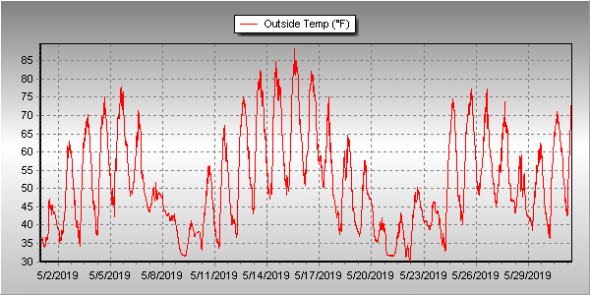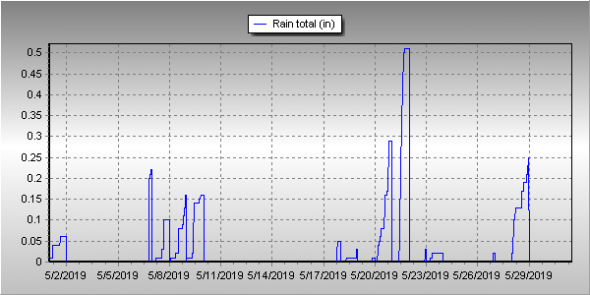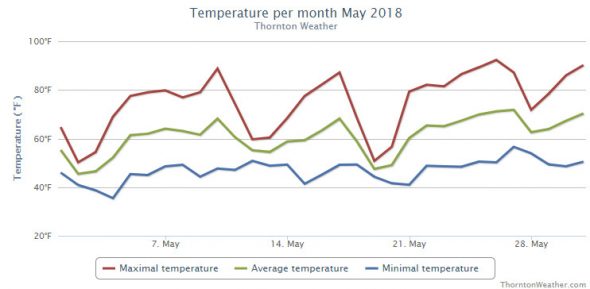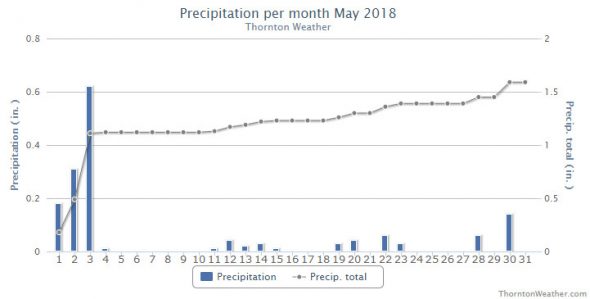Severe weather in spades is evident on our look back at Denver weather history this week. Notable is an F1 tornado in 1990 that moved through the Northglenn and Thornton area that damaged buildings, cars and trees.
From the National Weather Service:
20-27
In 2002…lightning sparked a wildfire near Deckers. Extremely dry conditions and very strong winds the following day allowed the fire…known as the Schoonover…to consume 3850 acres before it could be contained. Thirteen structures were destroyed…including 4 homes…resulting in 2.2 million dollars in damage.
23-24
In 2002…a pacific storm system brought much needed snow to the mountains and foothills with a mix of rain and snow on the plains. The most snow fell from central Jefferson County northward. Snow totals included: 13 inches in Coal Creek Canyon…11 inches near Evergreen and atop Gold Hill… 10 inches near Blackhawk and Conifer and atop Crow Hill… 9 inches near Rollinsville…and 8 inches near Genesee and Golden. Rain was mixed with snow across the city. Precipitation totaled 0.61 inch at Denver International Airport. Snowfall was less than an inch at the site of the former Stapleton International Airport. The storm brought unseasonably cold air to metro Denver. Three temperature records were set. Low temperature of 31 degrees on the 23rd was a record minimum for the date…as was the low of 32 degrees on the 24th. The high temperature of only 48 degrees equaled the record low maximum for the date.
24
In 1953…a microburst caused a brief wind gust to 55 mph at Stapleton Airport.
In 1957…walnut size hail…1 1/2 inches in diameter…fell in east Denver. Only 1/4 inch hail was measured at Stapleton Airport.
In 1958…rainfall totaled 1 to 2 inches across metro Denver. Rainfall was only 0.37 inches at Stapleton Airport.
In 1974…a tornado was observed briefly near Watkins. No damage was reported.
In 1980…strong gusty winds of at least 60 mph damaged buildings in parts of Denver. Several buildings were unroofed in Sheridan. The flying debris damaged other structures. Strong microburst winds gusted to 52 mph at Stapleton International Airport.
In 1991…a tornado touched down briefly in open country near Bennett. No damage was reported.
In 1994…weather spotters reported 2 funnel clouds over Aurora and a short-lived waterspout on Cheery Creek Reservoir.
In 1997…hail to 1 inch in diameter fell in Broomfield with 3/4 inch hail measured in Boulder.
In 1998…a tornado struck a wooden hangar at the Aurora airpark. The hangar collapsed…damaging a car and a single engine plane parked inside. An adjacent steel hangar sustained only minor damage. The tornado moved northeast…hopped I-70…and touched down again in an open field. Earlier…a weak tornado touched down briefly in an open field 10 miles southeast of Buckley Field.
In 2003…severe thunderstorms produced large hail over northern and southern metro Denver. Hail as large as 2 3/4 inches in diameter was measured 10 miles northwest of Hudson and to 2 inches in diameter 10 miles northeast of Fort Lupton. One inch diameter hail fell in Fort Lupton. Hail to 1 inch in diameter fell near Parker and to 3/4 inch near Franktown.
In 2004…severe thunderstorms moved across northwest and north metro Denver. Hail as large as 1 inch in diameter fell in Broomfield and Thornton with 3/4 inch hail measured near Arvada and Hudson and in the city of Denver.
In 2005…severe thunderstorms produced hail as large as 1 inch in diameter in Arvada and the city of Denver.
In 2014…a severe thunderstorm in Lakewood produced hail… Up to 1 inch in diameter.
In 2016…a long-lived supercell formed over south Denver and tracked across northeast Adams and continued to produce severe weather as into moved into Yuma County. The length of its path was approximately 121 miles. The storm produced hail up to 1.5 inches in diameter in southeast Denver. As it moved across northeast Adams County…several power poles were sheared off at the base by straight-line winds to 80 mph southwest of Leader. The damage path became more extensive as the storm moved into the northeast plains of Colorado. At Denver International Airport…1.15 inches of precipitation fell which set a new daily precipitation record. The storm produced heavier rainfall on one to two inches east of Denver…with over 4 inches in central Arapahoe County.
24-26
In 1996…a late spring snowstorm dumped 4 to 10 inches of snow over the Front Range foothills. Conifer picked up 10 inches of new snow; aspen springs…9 inches; and central city…8 inches. The sticky…heavy snow clung to power lines and pulled tree branches down…causing power outages to about 1200 homes in the conifer area. It took up to 6 hours to restore power to some residences. Lightning struck a telephone data cabinet in conifer on the 25th…which knocked out phone service to about 1500 customers. Widespread rain fell across metro Denver… Where rainfall totaled 2.07 inches at the site of the former Stapleton International Airport and 1.66 inches at Denver International Airport where north winds gusted to 24 mph on the 26th.
In 2010…high winds preceding a cold front… Swept across the Front Range foothills and urban corridor. In Aurora… The wind damaged the roof of Rangeview High School. In Conifer and Denver…the wind downed trees and power lines and caused several brief outages. The downed power lines also caused several cars to catch fire in the vicinity of 1590 Cook St. in Denver. Peak wind gusts included: 82 mph at Highlands Ranch…67 mph… 4 miles east of Franktown and Longmont; 65 mph in Boulder…64 mph in Centennial and Denver International Airport…62 mph near Parker and 60 mph in Arvada.
25
In 1877…lightning killed one person in west Denver and struck several houses. The bolt struck the house of the “home laundry” stunning the occupants and killing a lady who was holding one of her grand children in her arms. The child escaped unhurt. The lightning also struck the top of a tree in front of the house and partially peeled the bark off the tree. Lightning struck a church in the Evans addition and another tree in east Denver. Lightning struck the switch room at the telegraph office where the operator saw small balls of lightning pass across the room to the stove. The thunderstorm pelted the city with only pea size hail. Precipitation from the storm totaled 0.40 inch in downtown Denver.
In 1880…light rain all afternoon totaled only 0.24 inch in the city…but was valuable to stockmen and farmers due to the very dry…parched weather conditions on the plains.
In 1965…a tornado was sighted by a pilot 30 miles south southeast of Denver. No damage was reported. Another pilot reported 3/4 inch hail 30 miles east of Denver. The state patrol reported that a man was killed when a fierce gust of wind swept him from the back of a pick-up truck in northwest Douglas County. The man was holding a mattress in the bed of the truck.
In 1974…a microburst wind gust to 53 mph was recorded at Stapleton International Airport. A pilot reported a tornado 20 miles east of Denver.
In 1976…lightning struck a home in Boulder…shattering 2 large trees and damaging a television set.
In 1997…hail as large as 1 3/4 inches in diameter fell near Watkins. Hail to 3/4 inch in diameter fell in Broomfield and near Lockbuie.
In 2000…3/4 inch diameter hail fell at Cheery Creek Reservoir in Aurora. Thunderstorm winds gusted to 51 mph at Denver International Airport where small hail fell.
In 2006…a severe thunderstorm produced an estimated wind gust to 70 mph in Hudson. The strong winds damaged the roof of a home. A thunderstorm produced southwest wind gusts to 54 mph at Denver International Airport.
25-26
In 1950…a major storm dumped 10.0 inches of snowfall downtown and 10.7 inches at Stapleton Airport where northwest winds gusted to 30 mph on the 25th. The storm caused extensive damage to utility wires and trees which were in full leaf. A daily record minimum temperature of 31 degrees occurred on the 25th. This was the coldest temperature on this date in 79 years and for so late in the season.
In 1989…a late season snow storm dropped snow as low as 6 thousand feet along the Front Range. Most places in the foothills had 2 to 5 inches of snow. Overnight rainfall totaled 0.33 inch at Stapleton International Airport where north winds gusted to 37 mph on the 25th.
In 1994…lightning struck a television transmitter on Lookout Mountain near Golden and burned out a switcher…which disrupted cable service for 2 hours.
26
In 1897…apparent post-frontal north winds were sustained to 42 mph with gusts as high as 48 mph.
In 1942…the all-time highest recorded temperature in May…95 degrees…occurred.
In 1978…two children were struck and killed by lightning on a junior high school playground in Parker.
In 1987…1 inch diameter hail fell near Boulder and Bennett. The hail was fairly soft and caused no damage.
In 1993…dry thunderstorms produced wind gusts to 81 mph at Jefferson County airport near Broomfield. Several trees were blown down by the strong winds. Microburst winds gusted to 51 mph at Stapleton International Airport.
In 1995…a woman was injured in Littleton when the car she had just entered was struck by lightning. All of the windows in the car were blown out by the strike. A funnel cloud was sighted near Littleton.
In 2000…a strong microburst wind gust to 92 mph flipped a small airplane on its back and blew a dc-3 loose from its moorings…which allowed it to roll onto a grassy field at Front Range airport near Watkins.
In 2010…severe thunderstorms pounded parts of the urban corridor with very large hail…heavy rain… Damaging winds and a tornado. The hail…ranging in size from 1 inch to 2 3/4 inches in diameter…struck Brighton… Commerce City and northeast Denver the hardest. The storms continued to spread destruction to the north and east…impacting byers…Hudson… Deer Trail and Prospect Valley. The combination of hail and wind stripped the bark and branches from trees. Numerous accidents were reported as the hail accumulated up to a foot deep. Snowplows were called out to clear the roadways. Flash flooding occurred along State Highway 52 between Hudson and Keenesburg…and forcing the closure of the highway. Widespread crop damage was also reported as the area was inundated with up to 18 inches of water. Extensive damage to homes…businesses and automobiles was reported with the damage estimated to be around 70 million dollars. A tornado touched down near Denver International Airport…but did no damage. Lightning struck a child in Commerce City while she was watching television. She suffered minor injuries to her leg. At the Rocky Mountain Arsenal Wildlife Refuge…a lightning strike killed a bison. At Denver International Airport…only 0.01 inch of rainfall was observed… Along with a peak wind gust to 48 mph from the southeast.
In 2016…severe thunderstorms produced hail up to one inch in diameter near Castle Rock…The Pinery and Watkins.
26-31
In 1995…a cool period with light morning showers and moderate to heavy afternoon showers and thunderstorms pushed rivers already swollen from mountain snow melt over their banks causing minor flooding. Streams and rivers such as the South Platte and Boulder creek flooded meadowlands…bike paths…roads near streams…and other low lying areas. No significant property damage was reported and crop damage was unknown. Rainfall totaled 1.79 inches at the site of the former Stapleton International Airport and only 1.51 inches at Denver International Airport.
Continue reading May 24 to May 30: This week in Denver weather history








